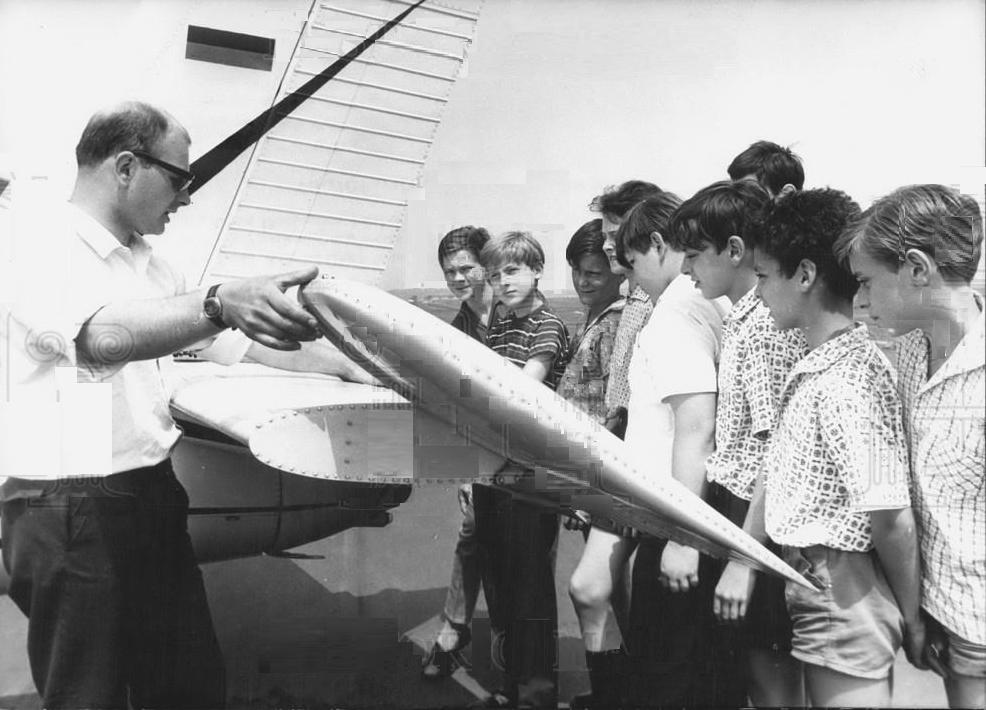
German School Activities: Field Trips --School Units

Figure 1.--This looks to be a school club fild trip rather than a school class trip. The boys are from Dusseldorf and the photograph is dated June 20, 1966. The press caption read, "In die Luft gehen: dürfen diese Düsselldrfer Volksschüler, um ihre Stadt eimmal von oben betrachten zu konnen. Die I dee zu diesem Unternehmen kam nicht von ungefahr: Eine Lehrkraft besitzt selbst den Pilotenschein und ist darüberhinaus Leiter der Modelbauklasse der betreffenden Schule. Der Deutsche AERO-Club Düsseldorf war mit dem Vorschlag einverstanden un ver anlasste, dass die 'Deutsche Luftsportjugend' ihres Vereins die eigens für Jugendliche bis u 15 Jahren zur Verfügung stehende Maschine von Typ 'Moran' für diesen 'Heimatkund?-unterricht aus der Luft' bereitstellte. UBz: Der Pilot erlautert den Jungens vor dem Abflug die Funktion von Hohen- und Seitenleitwerk." This trandlates as something like, "In the air, these Düsseldorf pupils are allowed to study elementary students from above. The idea for this company did not come about: a teacher himself has a pilot's license and is also the head of the model building class of the school in question. The German AERO-Club Dusseldorf agreed with the proposal and decided that the 'German Air Sports Youth' of their club would have the machine of the type 'Moran' for teenagers under the age of 15 for this homeland class lesson from the air 'provided. Shown here: The pilot explains to the boys before the departure of the function of vertical and vertical tail."
|
|
Field trips are normally organized by classes. This has a slightly diiferent meaning in oprimary and secondary schools. A primary class is an age-based group where the childrn spend most of the day together with the same teacher. They are faurly easy to identify as they are commonly groups of about 30 same age children. A secondary school class is a subject-based group with some age differences and based on hour periods with different specialy teachers. Thus class field trips are somewhat, but not visbly different. There also may be school club trips based on the interest extra-curricular interests of voluntary student groups. These groups could be smaller than normal class groups. There is another complication here. In English the term 'class' does not just mean a room of students, but also an age group. Larger schools might hgave several class groups of the same age groups. Field trips are not generally organized by the age group class, but school trips are often by these age groupings.
HBC-SU

Related Chronolgy Pages in the Boys' Historical Web Site
[Main Chronology Page]
[The 1880s]
[The 1890s]
[The 1900s]
[The 1910s] [The 1920s]
[The 1930s]
[The 1940s]
[The 1950s]
[The 1960s]
[The 1970s]
[The 1980s]
[The 1990s]
[The 2000s]
Related Style Pages in the Boys' Historical Web Site
[Main school uniform page]
[Main country page]
[Long pants suits]
[Short pants suits]
[Socks]
[Eton suits]
[Jacket and trousers]
[Blazer
[School sandals]
Navigate the Boys' Historical Clothing School Uniform Pages
[Return to the Main German school field trip page]
[Return to the Main German school outings page]
[Return to the Main German school activities page]
[Return to the Main School Uniform Page]
[Australia]
[England]
[France]
[Germany]
[Italy]
[Japan]
[New Zealand]
[Scotland]
[United States]
Navigate the HBC School Section:
[About Us]
[Activities]
[Chronology]
[Clothing styles]
[Countries]
[Debate]
[Economics]
[Garment]
[Gender]
[Hair]
[History]
[Home trends]
[Literary characters]
[School types]
[Significance]
[Transport and travel
[Uniform regulations]
[Year level]
[Other topics]
[Images]
[Links]
[Registration]
[Tools]
[Return to the Historic Boys' School Home]
Created: 12:20 AM 9/16/2018
Last updated: 12:21 AM 9/16/2018




